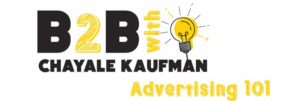Articles
B2B with Chayale Kaufman
January 6, 2022

Advertising 101 with Chayale Kaufman
Facilitated by Elisheva Braun
Chayale Kaufman owns and runs two advertising-related businesses: JCN and Consult Write.
The Jewish Content Network is a massive marketplace where business owners create customized advertising plans based on budget, goals, and target audience. With the click of a button, their campaigns go live.
Consult Write crafts campaigns from scratch, creating headlines, copy, and visuals.
While JCN is a digital platform, Consult Write—which handles the advertising process from beginning to end—does both print and online marketing strategies.
Why businesses and nonprofits are essentially the same
For years, organization owners have recognized that fund raising is a direct result of marketing. The numbers reflected this truth: 70 percent of JCN’s users were nonprofit organizations, while businesses comprised only 30 percent of the clientele. More recently, the market shifted to reflect business owners’ growing acknowledgment of the power of advertising. Our clientele is now 50 percent companies and 50 percent organizations, because both rely on their clientele for funding, and both need to consistently market in order to stay in business.
No matter which product, service, or good deed you offer, here’s why owners of any enterprise must invest in constant marketing: losing a patron or donor means losing business. If you aren’t reaching existing and potential clients, you are creating a gap for your competition to fill. In today’s aggressive and fast-moving marketplace, you need to stay in the forefront of consumers’ minds with consistent branding, messaging, and marketing.
Small-minded mindsets achieve small things
Thriftiness and frugality may feel like safe business-managing approaches, but when it comes to advertising, this mindset will cost you more than any campaign can.
Business visionaries recognize the need to invest in aggressive marketing; they know that with anything less, they will lose market share.
While in a business, the need to invest in advertising is obvious, nonprofit owners are constantly looking over their shoulders, afraid to upset donors by going too big or advertising too much. There is a social mindset that nonprofits must keep budgets slim and spend small.
But ultimately, it is about selling. Donors should be happy when big projects are rolled out; growth and expansion only bring more success to the organization.
How much should you spend?
Campaign budgets vary widely and depend on the goals of the operation. A new-product rollout, a one-time deal, and consistent branding each needs a different plan and budget.
For a small project, we always base the budget on the goals of the campaign.
For a bigger initiative, we have a two-step formula:
- Hit the demographic (which we study).
- Layer the campaign (based on budget).
First, we look at the target audience and choose platforms through which to speak to the people. Layering is contingent on the amount the client is willing to spend. Layering can mean using multiple media outlets, several-page spreads, videos, graphs, or whichever upgrades are effective for that campaign.
Use ads to touch people
The copy I create is not overcomplicated. It has energy and clarity, and it speaks to the humanity within every one of us. I believe that as people, our minds are all very similar. Although we are complex, we are all triggered by specific language and messaging. Based on the way I react to information, I can predict how others will react as well.
It’s all about teasing out the angle that makes the business or nonprofit both unique and relatable.
Once my team and I find the aspect that inspires and resonates with us, it becomes the central message of the campaign.
Ads are not only about putting the facts out there; their goal is to elicit a reaction and form a connection.
What makes our companies unique is that people feel the heart in our campaigns.
From foreign to approachable
It takes a skilled outsider to dig and find the aspect of what you do that will speak to others.
Recently, NASCK, the National Association of Chevra Kadisha, reached out for help with a fundraising campaign. Death is a topic we avoid; how could we create a compelling campaign about it? I was overwhelmed.
Then I heard about NASCK’s work, and it really resonated. We changed the narrative, creating a sense of meaning, warmth, and connection with the NASCK project. We made it all about family discussions and closeness, about protecting our heritage and our holiness. We took a topic that seems sad and scary and humanized it. That’s what we aim to do!